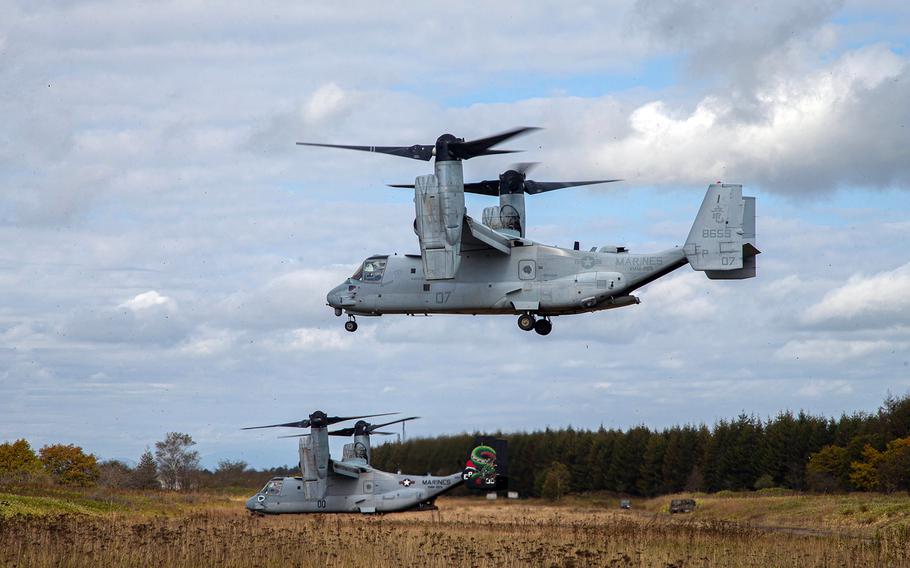Asia-Pacific
Japanese Ospreys will fly over Okinawa for first time during October exercise
Stars and Stripes September 15, 2023

Marine Corps MV-22B Ospreys with Marine Medium Tiltrotor Squadron 265 train in Hokkaido, Japan, Oct. 13, 2022. (Diana Jimenez/U.S. Marine Corps)
CAMP FOSTER, Okinawa — Japan’s army is poised to fly one of its tiltrotor aircraft over Okinawa for the first time despite objections from the prefectural government.
The V-22 Osprey from the Japan Ground Self-Defense Force is scheduled to take part in next month’s Resolute Dragon 23.2, a multi-domain exercise with the U.S. military.
Although a Japanese Osprey will make its first flight over Okinawa, two squadrons of Marine Ospreys fly there routinely from Marine Corps Air Station Futenma.
Since June 2022, eight Marines have died in two incidents involving Ospreys in Australia and the U.S. On Thursday, two Marine Ospreys diverted to airports in southwestern Japan after cockpit warning indications, according to a Marine spokesman on Okinawa.
Resolute Dragon 23.2, scheduled for Oct. 15-31 across Japan, will involve thousands of U.S. Marines and Japanese troops in stand-in force exercises, such as command and control, precision fires and maneuvering, III Marine Expeditionary Force spokesman 1st Lt. Alejandro Arteaga said by email Friday.
A stand-in force — a key tenet of the Marine Corps’ Force Design 2030 — is a smaller, mobile unit inserted within range of enemy missiles to seize and hold key islands and deny enemy vessels access to surrounding seas.
The Japanese Ospreys will ferry simulated casualties from New Ishigaki Airport on Ishigaki, 160 miles east of Taiwan, to Amami Oshima, northeast of Okinawa, and then to Kyushu, the southernmost of Japan’s main islands, a Ground Self-Defense Force spokesman said by email Friday.
Some government officials in Japan are required to speak to the media on condition of anonymity.
Okinawa prefecture lobbied the Okinawa Defense Bureau, which represents Japan’s Ministry of Defense on the island, and the Ground Self-Defense Force to exclude Japanese Ospreys from the exercise to “minimize the impact” to Okinawa’s local population, the prefectural Military Base Affairs Division announced Wednesday on X, formerly known as Twitter.
The Osprey has been a point of contention in Japan since it first arrived at Marine Corps Air Station Iwakuni on the main island of Honshu in July 2012. The aircraft’s development history, coupled with several high-profile crashes, has made it the target of an Okinawa protest movement.
Three Marines died and several others were hospitalized in Australia on Aug. 27 when their Osprey crashed during the multinational Talisman Sabre exercise. Two days later, Gen. Eric Smith, assistant commandant of the Marine Corps, ordered a “thorough and harsh” safety review. The review was expected to be completed Friday.
Another five Marines died in a June 2022 crash in the Southern California desert, an incident tied to an ongoing mechanical problem – a hard clutch engagement – in the gearbox, according to a Marine Corps accident investigation.
On Thursday, a pair of MV-22 Ospreys from Marine Corps Air Station Futenma on Okinawa made forced landings on remote Japanese islands due to “cockpit caution indications,” Maj. Rob Martins, a spokesman from the 1st Marine Aircraft Wing, said Friday by email.
The first aircraft diverted at around 1:45 p.m. to Amami Airport on Amami Oshima, Martins said. The second landed two hours later at Ishigaki Airport. The crews of both aircraft landed their respective tiltrotors safely.
No injuries or damage resulted, and the landings caused no delays at either airport, spokesmen from Kagoshima and Okinawa prefectures’ airport divisions said by phone Friday.
Marine maintainers were still troubleshooting the aircraft at both airports at 11 a.m. Friday, Martins said.
III MEF will contribute most of the 4,500 U.S. troops participating in Resolute Dragon next month, Arteaga said. Another 2,000 will come from Japan’s Western Army, Japanese public broadcaster NHK reported Thursday.
Training will take place across the country, from Hokkaido in the north to Yonaguni, an island 70 miles east of Taiwan.
About 80 U.S. soldiers and Marines will take part from Camp Ishigaki, a Ground Self-Defense Force base, for the first time.